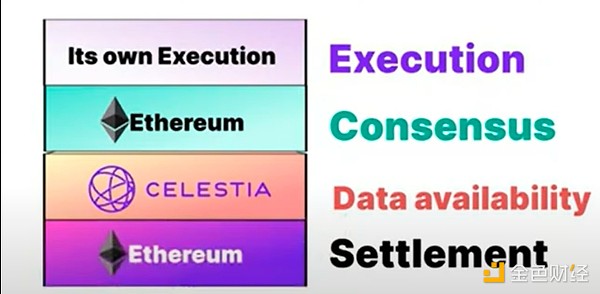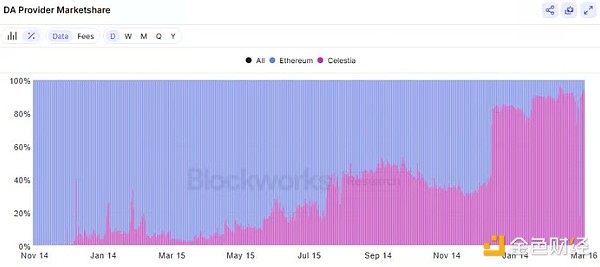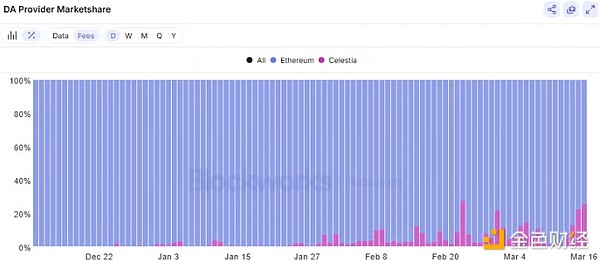Author: Michael Nadeau, The DeFi Report; Compiler: Deng Tong, Golden Finance
In this report, we narrow the scope and compare the construction of Ethereum today to the construction of the Internet, while introducing Celestia - it attempts to subvert Ethereum and become the default data availability (DA) solution serving Ethereum L2 and sovereign rollups.
Challenges of Ethereum
Ethereum's scaling roadmap presents two major obstacles for investors to overcome in this cycle, which did not exist in the 21st century cycle:
The massive influx of L2 tokens over the past few years has diluted the amount of venture capital that can flow into ETH as a long-term investment.
From an execution perspective, L2 improves Ethereum's base layer technology, which has led to a large part of its economy moving to L2.
From an investor’s perspective, this result can be understood from a report published this week by Standard Chartered – they estimate that Base has taken $50 billion of market cap away from Ethereum L1. As a result, Standard Chartered has lowered its year-end price target from $10k to $4k.
Given Ethereum’s lack of scalability at L1, it must be able to serve L2, which is its primary client going forward.
Ethereum owns this market today. But looking ahead, competitive threats are emerging.
To fully understand what is happening, we want to zoom out and compare the construction of Ethereum to the construction of the internet itself. Expounding on this first will help illuminate the challenges Ethereum currently faces.
Then, we introduce Celetia’s value proposition – which we will cover in detail later in the report.
Early Internet
In the early days of the web, if you wanted to create a website, you had to host your own physical server - which was costly and didn't scale well.
We solved this problem by creating shared server hosting. By leveraging hosting services like GeoCities, this made it easier and cheaper to build a website.
The internet began to expand, and it became cheaper for entrepreneurs to build websites offering products and services.
Eventually, innovation was limited by the shared execution that GeoCities provided. Virtual servers emerged - which provided the scalability + customization/flexibility of your own server, but with the convenience of using shared hosting. Amazon Web Services was born.
With AWS came e-commerce, SaaS companies, and social media - all of which would have been impossible in the early days of the internet.
Today, the same process is happening with public blockchains — they introduced a new data structure to the internet with global accounting ledgers and digital property rights.
It started out as a clunky, inefficient, and expensive user experience, then became lean, cheap, and fast.
Public Blockchains and Ethereum
Bitcoin was the first public blockchain. In the early days of web3, if you wanted to create new applications using this groundbreaking new technology, you had to start with your own blockchain. Bitcoin’s forks (peer-to-peer naming systems) were an early example. This era of public blockchains was similar to the early web — when you had to host your own servers to build a website.
Ethereum came to prominence in 2015. We can think of L1 as the “GeoCities of web3.” Why? Ethereum enables developers to launch applications using shared infrastructure. No need to launch your own chain and bootstrap validators. This is similar to GeoCities, which allowed developers to build websites without hosting on their own servers.
Of course, developers want more throughput and flexibility to build specialized use cases.
Enter Ethereum L2s — execution environments built “on top” of L1, with Ethereum as the infrastructure for data availability and security.
Now, Ethereum is starting to look like a “network of networks” — similar to how the internet itself was built.
However, some challenges remain. In particular, Ethereum’s DA costs are still quite high. This opens the door for competitors like Celestia to serve Ethereum’s L2 clients, similar to how AWS serves web2 applications in the current cloud era.
Now. Given Celestia’s early success, we have to ask the question: Is Celestia a threat to Ethereum’s L2 roadmap?
What happens if Ethereum L2 moves to a solution like Celestia?
About Celestia
Celestia is a proof-of-stake blockchain (currently with 100 validators) that specifically addresses the problem of data availability verification — in the past, verification required nodes to download all transactions in a block. They solved this problem with data availability sampling — guaranteeing data availability without nodes having to download the data.
Their target customers are other blockchains.
Now, let’s say you’re Robinhood. You have over 20 million users trading stocks and options on your platform each month. At the same time, cryptocurrency trading has become a significant part of your business (35% of revenue in Q4).
Let’s say you decide to further integrate into the cryptocurrency infrastructure because you see a future where all assets will be tokenized for trading and settlement/accounting.
Naturally, you decide that the best way to capture the most value while maintaining control and flexibility is to build an L2 on Ethereum (which has the best network effects in crypto).
You need the following components to make it all work:
Execution: Processes trades, swaps, payments, and other user actions
Consensus: Makes sure no one cheats and everyone plays by the same rules (think of consensus as security)
Data availability: Makes the history of what happened (the data) available for audit by others or for other applications to access
Settlement: Final accounting/scoreboard
If you’re Robinhood, you’ll want to build your own sovereign L2 where you control execution. However, you probably don’t want to build your own validator network for consensus/security. Maybe you’ll use Ethereum for that.
Of course, you need to make all your data auditable/verifiable by others and accessible to other applications. You could use Ethereum for this, too. But Celestia is 100x cheaper + it lets you integrate with other L2s, even with Solana (in the future), and make your data available there.
Maybe you choose Celestia as your DA layer.
Finally, you need a place to account for all user activity as a "final scoreboard". Given Ethereum's security, decentralization, and lindy, you choose it as your official accounting ledger.
Here’s your tech stack:

What problem does Celestia solve for Robinhood?
Celestia makes it easier for Robinhood to:
Own its own execution environment.
Leverage Ethereum for consensus and settlement — something Ethereum excels at as the most secure and decentralized L1.
Leveraging Celestia for data availability is much cheaper than using Ethereum (100x cheaper today).
In the future, if Celestia is able to build an L2 network (with native bridging) that leverages it for data availability, Robinhood could benefit from providing access to its data to everyone in that network. Furthermore, assuming Celestia can connect to L1 in a native, seamless experience (not an easy feat), Celestia could even provide access to its data to applications and users on other chains.
Key Points:
You may have heard the term “money legos” used when referring to the composability of DeFi applications. Celestia is committed to providing this experience for sovereign rollups that want to customize their tech stack, while making data usable across a variety of chains/applications/and execution environments.
L1s currently achieve network effects through shared standards (tokens, smart contracts, developer tools, etc.). Celestia seeks to create network effects between L1s and L2s as a key “middleware” protocol for the web3 tech stack. This is a great idea. It aims to create network effects as the “default DA solution” through “blob fees” — a standard that all L2s will choose when using Celestia. This could give it a “moat” due to its composability with other rollups and L1s — solving for fragmented liquidity and user bases between L1s and L2s. Again, this is a great idea, not an easy one.
To succeed, it needs to acquire the largest L2s as clients (which it currently does not have) and become the default choice for all new entrants.
There are many reasons why Robinhood (and existing L2s) may want to stick with Ethereum instead of Celestia.
Security Risks. Ethereum assumes that DA and settlement are unified when validating rollups. If Robinhood posts data to Celestia but settles to Ethereum, Ethereum cannot natively verify Celestia’s DA guarantees. This increases trust assumptions for Ethereum validators, who must rely on external monitoring by Celestia.
Risks and Rewards. Ethereum is the most decentralized and secure smart contract network today. At this emerging stage, choosing a less mature alternative may be seen as high risk, low reward.
Celestia Adoption
As mentioned before, Celestia needs to attract the largest, most successful rollups + most new entrants. Why? It needs to attract the largest customers, then connect them all together — so that a seamless user experience can be created for future builders who want access to users and data on all chains, while having data verifiable by anyone.
If this momentum is achieved, Celestia (as the middleware connecting all chains via data availability) could become one of the most important protocols in web3 (similar to Bitcoin, Ethereum, and Solana).
Of course, this is still a long way to go.
Current Progress
Celestia is less than 1.5 years old. But it is already the leading DA solution in crypto, currently with 90% of the market share in terms of the amount of data released.

Top Clients
General L2: 86.7% (Eclipse, Solana Virtual Machine (SVM) L2 make up the vast majority of data released to Celestia today)
Gaming L2: 2.8%
Finance L2: 1.7%
Social L2: .5%
Consumer L2: .12%
In total, there are about 30 rollups releasing data to Celestia today. It secures ~$500M in value.
As mentioned previously, Celestia has yet to secure one of the top Ethereum L2s to leverage it for DA. We think their goal is to get a top L2 moving and then become the “default DA solution” for new entrants. From there, they can achieve network effects and a “moat” through a new standard around “blob fees” — enabling cross-chain composability.
That being said, we think L2s like Base, Arbitrum, and Optimism have little incentive to leave Ethereum today.
Celestia Business Model and Fees

While Celestia has about 90% market share in terms of publishing data, it only has 25% market share in terms of fees (because the cost is lower than Ethereum). It currently charges about $20,000-25,000 per day in fees.
Fees are set as low as possible to prevent spam. The goal is to form network effects today and control pricing power later.
Ultimately, Celestia's pricing power will come from its network effect as a unified standard for L2 and L1. Without network effects, there is no pricing power.
Addressable Market
It’s all about economies of scale. The Celestia addressable market includes all Ethereum rollups, sovereign appchains, and potential L2s that settle to Solana or other L1s.
Eventually, Celestia believes there could be more chains than there are websites.
The goal is to charge fees of about 1/10th of a cent for large transactions.
Will Celestia be the “AWS for web3”?
Just as AWS facilitated the adoption of web applications by handling the heavy lifting of servers and scalability, Celestia can facilitate the adoption of custom blockchain applications by handling data availability at scale.
With Celestia, developers can deploy their own chain (rollup or sovereign) without recruiting hundreds of validators or inventing a new consensus protocol. This is similar to how startups use AWS to spin up cloud servers instead of buying physical servers.
The end result of Web2 is a significantly lower barrier to entry. Therefore, Celestia believes that if web3 use cases can achieve network effects as the default solution for developers who need a custom web3 stack, then their potential market could expand significantly.
AWS has had a huge impact on the adoption of websites and applications on the Internet by removing infrastructure barriers and reducing costs.
Celestia is looking to do the same for the adoption of rollup and sovereign blockchains.
Summary
The Internet is made up of a series of decentralized protocols that ultimately enabled global information (data) sharing so that a single computer can access all the content in the world.
But this didn't happen overnight. It was a process of combining key protocols (such as TCP/IP, HTTP, DNS, etc.) with tools like AWS to eventually create the Internet we have today.
In many ways, web3 is being built in a similar decentralized way.
Ultimately, there needs to be a “connective tissue” across chains and data to provide a user experience in web3 similar to what we have in web2.
Celestia hopes to be that “connective tissue”.
They are betting on an optimistic future where developers will want to have unfettered flexibility to build web3 applications while making data accessible to everyone.
We think they may have found a solution today.
But the technology is not enough. They need to create a massive network effect between L2 and L1 through cross-chain composability to achieve this vision.
This will not be easy.
But given the current valuation, addressable market, team, backers, early lead, and lack of competition in the market today (other than Ethereum), we think Celestia is best suited to solve this problem.
Ultimately, we believe that betting on Celestia is a bet on web3 scaling (website-scale blockchain proliferation) and a hedge against Ethereum and its ability to successfully execute its L2 roadmap.
 Clement
Clement
 Clement
Clement Catherine
Catherine Hui Xin
Hui Xin Clement
Clement Brian
Brian Aaron
Aaron Jixu
Jixu Jasper
Jasper Clement
Clement Kikyo
Kikyo